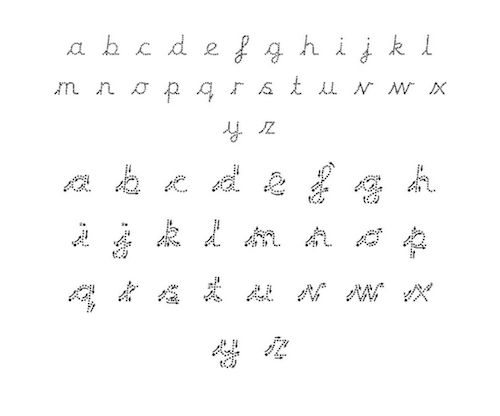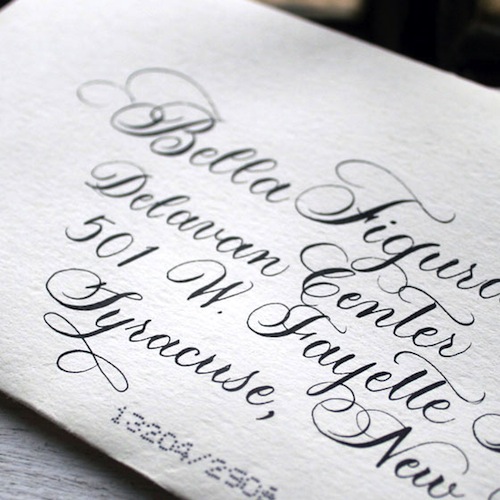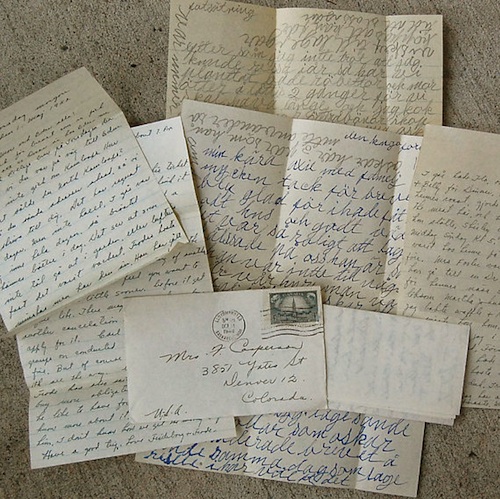
Image Credit: Birdsedge First School
Remember these things? It's hard to believe that kids are still learning to shape their letters according to handwriting diagrams like this one. In the first world where type is the dominant mode of textual presentation, one has to wonder how often kids will encounter a squiggly 'f' as it's drawn above or a lower case 'k' that looks like a capital R?
The chart looks to us like an anachronism, especially next the digital text of this blog post. We're prompted to ask whether kids should be taught to write a script that is rapidly fading from the textual universe? Is handwriting a skill that is worth acquiring in an era when written communication mainly occurs through digital media, without the assistance of pen or paper?

Image Credit: www.bellafigura.com
One compelling argument for keeping handwriting around is that it can be very pretty, and therefore affective. A friend's wedding invitation came in the mail recently and it got me thinking about the decorative and emotional value of handwriting. The envelope was addressed in beautiful cursive, a standard touch for formal invitations 20 years ago but certainly not the norm today. Now couples often have their envelopes labelled with digital fonts or will deliver invitations entirely online. It's only the occasional couple who busts out the fountain pen and ruler and puts their cursive skills to work. In my book this doubles the couple's charm factor as well as increases the likelihood that I will attend their wedding. There's something about the slightly imperfect symmetry of handwritten script that marks a card as personal, and this consideration for the guest I think presages a good wedding party. (On the other hand, an open bar probably has more to do with a successful wedding reception than the writing on the invitation).
Another case where I think the handwriting remains rhetorically impactful is in letter writing. Someone recently told me about how their sister's fiance asked her father for permission to marry her in a handwritten letter. This made me wonder whether handwriting, especially in the Digital Age, lends writers a particular gravitas that printed text does not. Students of literary manuscripts will tell you that handwriting can reveal a good deal about a writer's process; small variations or mistakes can show where the writer hesitated, where s/he struggled to find the right expression, where s/he wrote with confidence. Perhaps, then, it is a more honest medium than type because it betrays these writerly hiccups rather than masking them with uniform letters. The appearance of honesty, openness, and having thought about what one has said are all things I imagine one wants to cultivate when asking a man for his daughter's hand.

Image Credit: www.etsy.com
Did the handwritten form of prisoner Kim Millbrook's petition to sue the federal government work in his favor? After the felon's case was rejected by lower courts (he is suing the government as the employer of a group of prison guards who he claims sexually assaulted him at the federal penitentiary in Lewisburg, Pa.) the Supreme Court picked up his "pauper's petition" which was written rather pathetically in longhand. In a case like this where the federal courts' so-called immunity from prisoners' allegations is at issue, the rudimentary style in which Millbrook addressed the Justices underscores his cause. His crude petition highlights the basic imbalance of resources, power, and human rights that always exists between a prisoner and the federal government.
The last thing I want to say about handwriting is that as much as technology has seemed to erase the need to write legibly with paper and pen, the impetus to take handwritten notes to record and organize one's thoughts is still remarkably strong. It's strong enough to power a whole market of note-taking applications, such as Penultimate or Notability, which allow iPad users to write on all kinds of digital surfaces (pdfs, presentation slides, websites, etc.).
So, in summary, it seems like handwriting is not going away anytime soon. But its utility and cultural significance have certainly changed. We rely on it less and less as a medium for communicating content audiences as we have become increasingly bad at deciphering other people's handwriting. As rhetors, we occasionally exploit the presentation value of handwriting to add gravity, romance, or pathos to our appeals. And finally, functionally speaking, I wonder if the only advantages handwriting has over typing are its mnemonic characteristics--its flexibility, variability, and particularity--which would seem to narrow its field of usefulness to notes that are meant only for oneself.
Recent comments
2 years 29 weeks ago
2 years 44 weeks ago
2 years 44 weeks ago
2 years 50 weeks ago
3 years 4 weeks ago
3 years 4 weeks ago
3 years 4 weeks ago
3 years 6 weeks ago
3 years 6 weeks ago
3 years 6 weeks ago